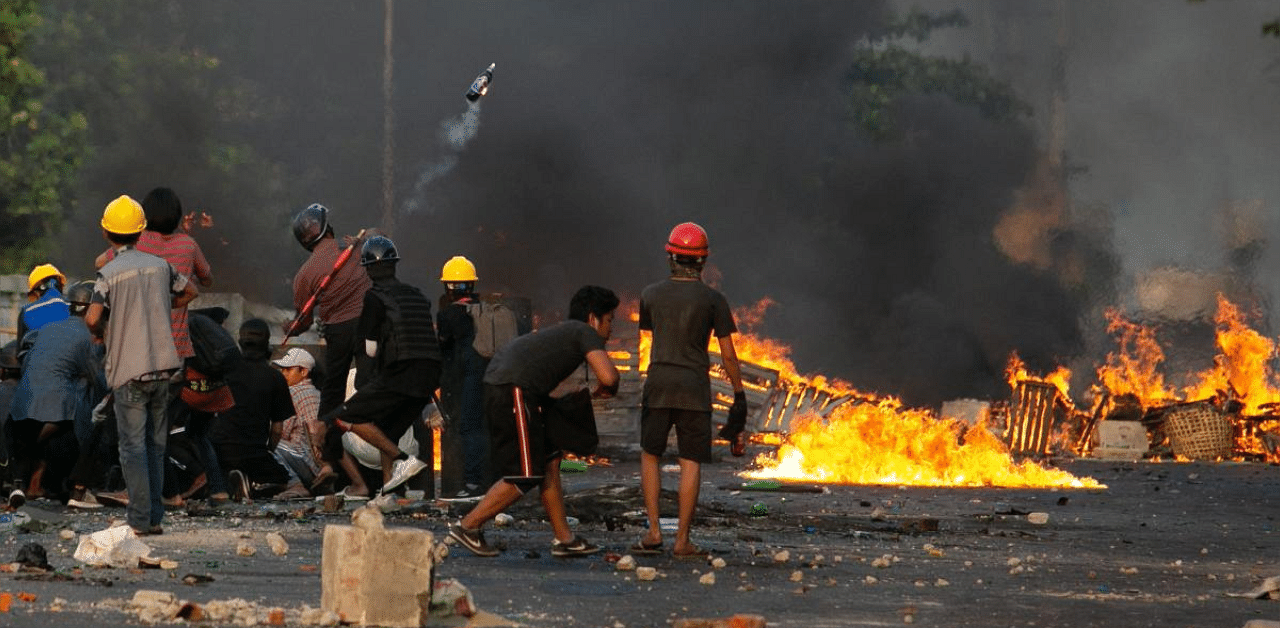
Plumes of smoke rose Wednesday above a part of Myanmar's biggest city under martial law which has turned into a battle zone, with burning barricades and security forces firing at unarmed anti-coup protesters.
Traumatised residents have fled the industrial neighbourhood in Yangon that has become one of the flashpoint sites in a nationwide uprising against the military's coup nearly seven weeks ago.
The junta has increasingly deployed a heavier force to quell the demonstrations, with more than 200 protesters reported to have been killed in the crackdown.
Sunday was the deadliest day since the coup, with a local monitoring group documenting more than 70 people killed -- the bulk of them in the industrial Hlaing Tharyar township in Yangon that has become the battle zone.
The junta on Sunday imposed martial law on Hlaing Tharyar and later on other protest hotspot townships -- effectively placing nearly two million people under complete control of military commanders.
Residents -- many of them migrant workers -- have since fled back to their home states, piling their belongings and families onto flat-bed trucks and the backs of motorbikes.
Those who stayed reported scenes akin to war.
"There was constant gunshots the entire night and we didn't get to sleep," one resident told AFP, adding people were worried about even walking on the streets for fear of getting targeted by security forces.
Another resident, a medical student, said there was a heavy military and police presence around the main parts of the township.
"They were checking cars, motorbikes and the mobile phones of people going around the streets," he told AFP.
"If they detected anything related to politics and the civil disobedience movement, they arrested people," he said, adding that authorities also threatened residents to make them remove barricades around the area.
Hardline anti-coup protesters had camped on a bridge leading into the township's main roads on Tuesday evening, wearing hard hats, gas masks and carrying shields.
Read more: Myanmar protesters defiant in face of deadly crackdown
They had also erected barricades made out of tyres, wood, sandbags and bamboo poles.
Some of those barricades were burnt, leading to heavy black smoke rising above the mostly deserted streets.
Some protesters threw petrol bombs at the security forces, but otherwise appeared defenceless as they hid behind makeshift shields.
In a residential area of a neighbouring township, video footage verified by AFP showed volleys of gunfire going non-stop for roughly 15 seconds.
Information on arrests and violence have been trickling out of the conflict areas on social media -- the flow slowed due to the junta's throttling of mobile data.
Much of Myanmar has not been able to use their mobile internet since the early hours of Monday.
The country is also placed under a nightly internet shutdown for eight hours.
More than 200 people have died in anti-coup unrest, according to the Assistance Association for Political Prisoners, a local monitoring group.
But protesters continued taking to the streets Wednesday, with local media broadcasting images of people marching through northern Hpakant and central Sagaing region.
In the country's second-largest city Mandalay, saffron-robed monks marched alongside demonstrators carrying the red flags of Suu Kyi's National League for Democracy party.
The United Nations on Tuesday again condemned the deaths in Myanmar, adding it was worried about reports of torture and deaths of those in custody.
"The death toll has soared over the past week in Myanmar, where security forces have been using lethal force increasingly aggressively against peaceful protesters," UN rights office spokeswoman Ravina Shamdasani told reporters.
"Deeply distressing reports of torture in custody have also emerged."
The office had determined that "at least five deaths in custody have occurred in recent weeks," she said, adding that "at least two victims' bodies have shown signs of severe physical abuse indicating that they were tortured."